 |
  |
 |
  |
Inventing of a Notation System for Mudra: The language of Dance and Theatre in Kerala - Part 1 - G. Venu e-mail: abhinayakairali@gmail.com April 27, 2019 Dance Notation Dance Notation is the medium by which the body movements are scientifically analysed and are delineated accordingly through the appropriate use of symbols. There is documentary evidence to show that from the 15th century itself dance was notated in the West. Recently I happened to read that even many centuries prior to this, the dance steps of Buddhist rituals in Tibet were documented using signs. The most popular notation systems available for Western dance is 'Labanotation' and 'Banesh System'. I did try to learn 'Labanotation'. In the Western style of dance, importance is given to the movement of the parts of the body and choreography. But in Indian dances, equal importance is given to all the constituent parts and subparts from the head to the foot. The different parts of the body have different movements. The notation system of the West and their symbols is not sufficient to document the Indian dance forms. Dr. Kapila Vatsyayan who had studied 'Labanotation' much earlier has also made similar observations. I have devised a dance notation system to record Kathakali mudras in 1965. This article is about delineating and publishing 1752 mudras of Kathakali, Mohiniyattam and Kutiyattam over the years which has become perhaps the world's largest collection of hand gestures. 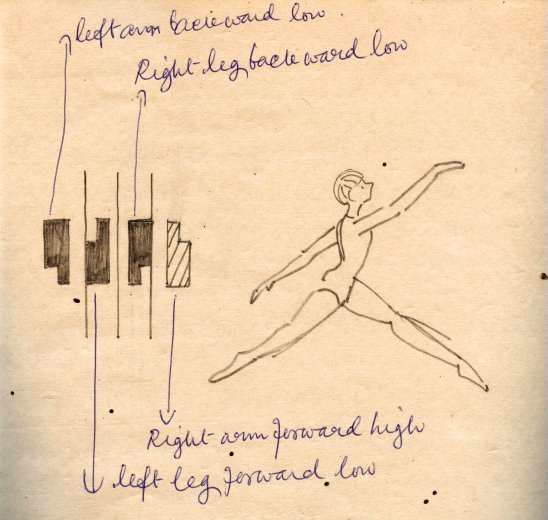 A page from Venu's Study based on Labanotation or Kinetography Laban by Dr. Ann Hutchinson [1969] 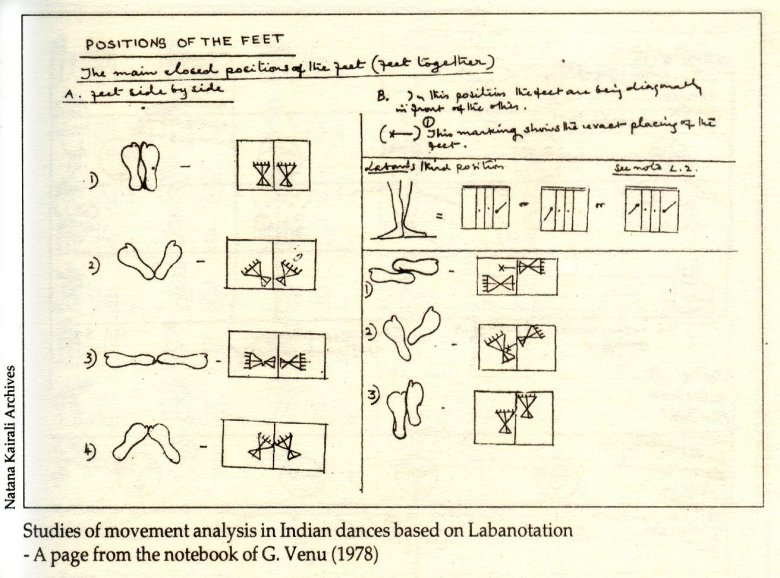 Studies of movement analysis in Indian dances based on Labanotation - A page from the notebook of G. Venu [1978] In the world of Kathakali I saw Kathakali for the first time when I was studying in the fifth standard. It was at a festival at the Nedumangad Mukkolakkal Bhagavaty temple. I vaguely remember it to be Narakasuravadham. Someone made me sit in the dressing room. In those days small temples did not have separate dressing rooms for Kathakali. Makeshift arrangements were made and the neighbours' cowshed was cleaned up to function as the dressing room which was a little away from the stage. When the make-up was done for the demoness (Karivesham) someone lit the fire torch to lead the way. Many children accompanied the artist to the stage with a lot of noise. Since there were people all around, the actor was in the mood of the character as he walked up. It was a fantastic experience. I was in a dream world where people from an unknown world came upon the stage singing and dancing, kept appearing and disappearing. My excitement was boundless. The performance I saw that day was a turning point in my life. It aroused my desire to enter the wonderful world of Kathakali. From the next day onwards, I used to gather whatever clothes that were available and started dancing. My elder brother Rajan Nair was my accompanist, beating rhythm with an empty tin. For many days in the evening this was our entertainment. My father heard about it and with a few of his friends once secretly saw our play. He was impressed and the very next day he started to look for a Kathakali teacher. I started training in Kathakali on the next Vijayadasami day in the attakkalari (training centre) my father had started. Keerikkattu Sankara Pillai, the only son of Keerikkattu Kochu Velu Pillai who once strode Kathakali venues in the South, was the Asan (Guru). Though Sankara Pillai trained under his father, he did not shine very much on the stage. But he was a strict teacher. The kalari was near the temple Karippuru Mudippura, about two miles from our house. I would have an early supper and by twilight walk to the kalari. There were three others who trained with me. At the initial stages, in the evening we learnt exercise of the eye, training in rhythm, and hand gestures. By ten o'clock all four of us would go to sleep on two mattresses in the kalari. We never had any pillows. At three in the morning, when we were deep in sleep, Asan would wake us up. We were all scared of him and so we promptly got up and ran to wash our face. 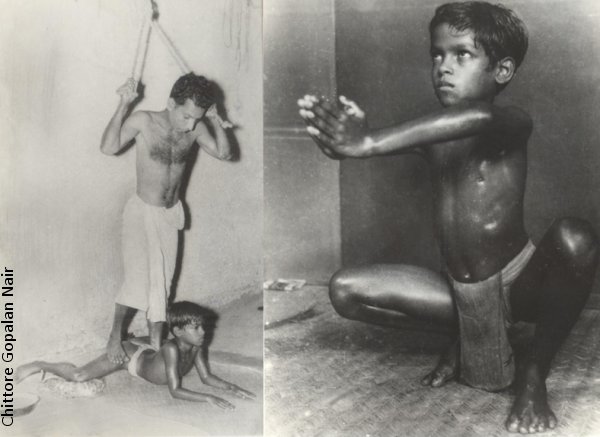 Keerikkattu Sankara Pillai and his disciple G. Venu [1956] - Massage during Kathakali training After physical exercises, we would start with the first foot work in Chembata rhythm in a slow speed, ascend to the fourth speed gradually and descend to the first. The first step 'titta tatta' was practiced for months together. The training of the steps was so strenuous especially when the knees were bent and the heel touched the knee, each time before stamping. This was extremely painful, especially for the body below the hip that one almost wanted to die. During the monsoon, for two months, Asan himself would do oil massage on our body. During this period, in the evening there would be Cholliyattam. Thoongayil Bhaskara Pillai was the vocalist and Keerikkattu Vasu Pillai played the Chenda (drum). We had to get up on these days at three thirty. We would have our bath at five thirty and reach home. By then it would be time to go to school. We had to walk three miles to the school. In spite of all these difficulties, I never wanted to give up my Kathakali training. This, for me, is the power of art. My training from the beginning itself was with a lot of enthusiasm and a feeling that I was in a wonderful world. Our enthusiasm will grow the more we study what we like. My first performance on the public stage was when I was thirteen. The kalari continued to function well for few more months after this. Then my father was forced to wind up the kalari due to financial crisis. When the kalari was ended, Asan suggested that I should be sent to a noted Kathakali school for further training but my father was not interested in it. My father firmly believed that classical art forms must be trained only through a mentor neophyte relationship. The second stage of my Kathakali learning started at Viswakala Kendra, at Vattiyoorkavu, Thiruvananthapuram, established by Guru Gopinath. When Guru Gopinath started the Viswakala Kendra in 1963, I joined as his student. He was one of the most famous dancers in India. I became his admirer from the moment I saw pictures of his abhinaya of the Navarasas in a publication. His face had all the features for a dancer; added to that was a unique attractiveness and dazzle. 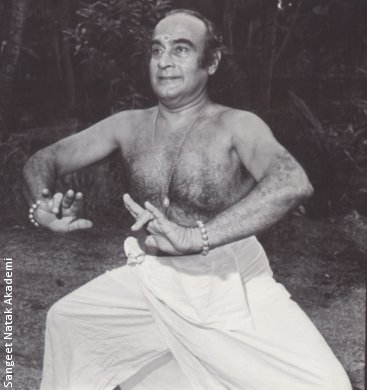 Guru Gopinath demonstrating a Mudra [1964] My father knew Guru Gopinath and was on good terms with him. My father used to tell me that there was a lot to learn from him for he was not just an artiste. Guru Gopinath embodied a rare personality fit for emulation. This also inspired me to become his disciple. He had started his kalari in Vattiyoorkavu more or less on the lines of the Gurukulam tradition. "I wish to teach here the Kathakali of the southern style in all its completeness. I have studied mainly that. It is from this that I have drawn concepts for my new dance creations. There will be an erosion if trained only in my compositions," he used to say. It was a time when Kathakali was not an attractive profession. Most of the Kathakali performers whom I had known then were not on safe grounds financially. The training itself was difficult and then to top it off was the difficulty experienced in surviving as an artiste. Moreover, the earnings were very meagre. In spite of all this, Kathakali had seduced me and I wanted to continue with my training. Guru Gopinath had about sixteen acres of land in Vattiyoorkavu. He constructed training spaces there and started teaching. In the beginning it was only Guruji who taught us. He would be in the kalari every morning at exactly four thirty. He would recollect and train us in physical exercise, steps and kalasams in the Kaplingadan style. He used to say that he was following the style of Southern Kathakali of the great Mathur Kunju Pillai Paniker. After some months, Keeritkkattu Sankara Pillai was appointed as Asan. Every now and then for singing accompaniment, Thakazhi Madhava Kurup and Madavoor Vasu Pillai (Bhagavatar) used to come. When it was the season for massage, Guruji also used to come to do massage. Training in the kalari became lively when we started the Cholliyattam of the stories Rukmini Swayamvaram, Kalyana Saugandhikam, Daksha Yagam and Nala Charitam (first day). As I was very enthusiastic, Guruji used to specially give class for me every day for two hours. He used to explain in detail the concepts behind every gesture, expression, and movements of what we were doing. He taught me for six months the Padam "Kanninakkanandam" in Daksha Yagam. Everyday there would be innovations that he introduced based on traditional knowledge mixed with his own imaginativeness and improvisation. He taught me the movement of the swan and gestures in particular as part of the immense potential that a line like "pulinangal tannil nalla kalahamsaleela kandu" (I saw beautiful swans playing on the river banks) has. He used to say that birds have different gestures and they should be carefully observed before enacting them. Guruji analysed the concept of abhinaya with an analytical mind. He was the one who enabled the scientific text of hand gestures Hastalakshanadipika to reach the common man. Guruji used to say that when he was a student at Kerala Kalamandalam, he was taught this treatise of hastamudras by the great scholar Kuttikrishna Marar. He has published in his books Abhinayankuram and Kathakalinatanam the relevant parts of Hastalakshanadipika with attractive pictures in both Malayalam and English. My training under Guruji revealed to me the infinite possibilities latent in Kathakali mudras. It was when I was training in Viswa Kala Kendra that my attention was drawn to the hand gestures in Kathakali and had the first spark of the idea about the medium to record the Kathakali mudras. I realized that many rare aspects of the mudras in Kathakali could be wiped off the face of the earth for the simple reason that they are not inscribed anywhere. They have been sustained only through oral traditions. It is in this context I decided that I should inscribe the Kathakali mudras. Like spoken language, Kathakali gestures are a complete mode of communication. It is very often possible to express our emotions and thoughts through this more forcefully than through words. The possibilities of hand gestures, the symbolism and the magical power of enacting the padams, had greatly influenced me. The attraction was so great that day and night I was thinking only about this. I thought that a proper alphabet is needed to document this sign language. The prolonged obsession with this thought and the desire to do something in this area ultimately led to the formulation of the symbolic signs of the mudras of Kathakali. 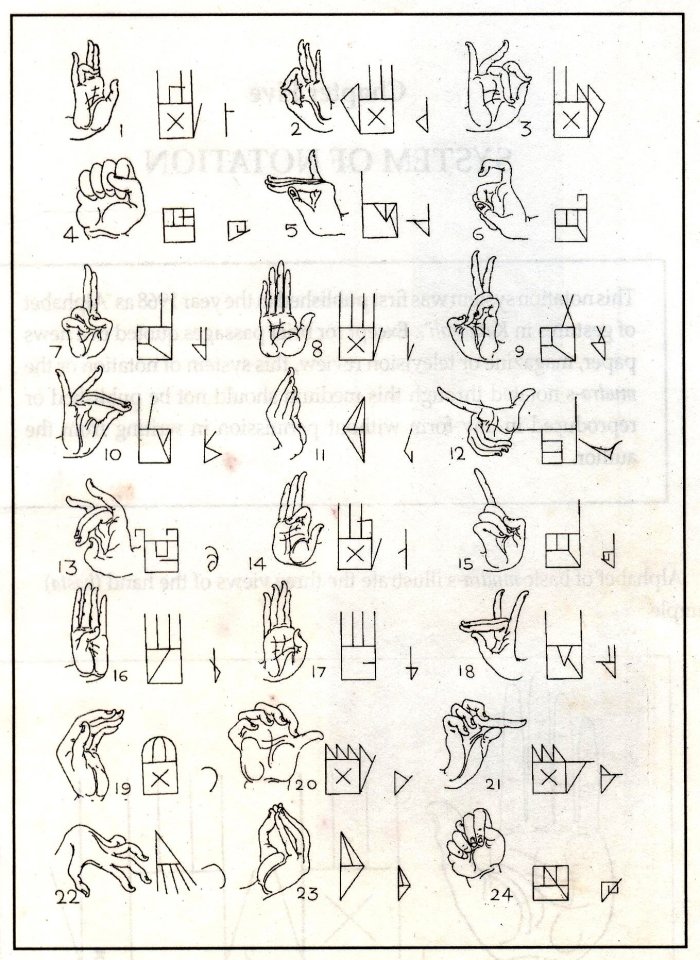 Alphabet representing the twenty four basic mudras of Hastalakshanadeepika (devised by G. Venu in 1965) On a rainy night, as I sat alone in my father's studio, my whole thoughts were absorbed by the most suitable medium that would help to record the mudras. It was raining cats and dogs outside, accompanied by thunder and lightning. I sat with a pencil and paper. My mind was surging with Mudras. Sometime around midnight the alphabet for the first Mudra - 'Pataka' was formulated in my mind. I got excited, and like a torrent within no time I could formulate alphabets for 24 Mudras. I drew them in black ink. After completing all the basic mudras I enjoyed looking at them till four o'clock in the morning. I slept after sometime. Later, within a few days, I formulated a system of delineation for the variation of hasta mudras such as the movements, and the staff that divided the body into three. I used to write every day the mudras that I learnt and understood in my training period. I was particular that the signs must be simple and at the same time be symbolic and reveal the shape of the mudras. While communicating through gestures, their position in relation to human body, and even the smallest of movements of the fingers are very important. Therefore I also analysed the minute movements of wrist and fingers and have conceived graphic symbols. Since I have practical experience in Kathakali, it was not difficult to analyse the movements in order to evolve the signs. Exposure to painting from early child hood also made it easy to illustrate the mudras on paper. 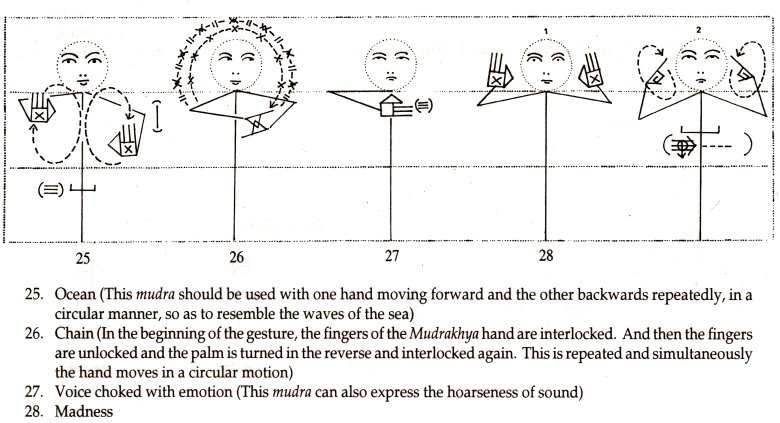 From the book 'The language of Kathakali' by G. Venu During the holidays, whole nights were spent on drawing. It was an elaborate process. I would make sure that the delineation were perfect by doing them myself again and again, trying to grasp the subtleties of each movement. I cleared my doubts with Sankara Pillai Asan, who knew the different shades of each word, and was a great help to me in my endeavor. By this time I had fairly good training in Kathakali but I did not give much importance to acting. On the other hand, I gave importance to research in hand gestures and other concepts of abhinaya in Kathakali. In those days, I used to sit through Kathakali performances with my note book and pencil. If an actor showed a mudra that I did not know, I would immediately make a note of it in my short hand. Whatever I did not understand, I would ask immediately for clarification. Apart from this, I read all the available books on dance and performance arts. As a student in school, I never liked to do homework. But now I would sit through the night reading with enthusiasm and make notes. It took some time for the members in the household to adjust with this change in me. When I completed almost three hundred Mudras I showed them to Guruji with great apprehension and fear. When I showed him my manuscript he took pains to examine them very carefully. He demonstrated some of them while going through the book. Then he commented thus: "It is Raman Pillai Chettan (Guru Chengannur Raman Pillai) who is in authoritative possession of the mudras in the Kaplingadan style. It will be the right thing to ask him to examine all these mudras." I had a very good relationship with Raman Pillai Asan. Whenever he came to Thiruvananthapuram and the nearby places for performance I used to tag myself to him. He was about eighty years old at that time. I often helped him in the green room. It was in the Kathivesham that Raman Pillai Asan became famous. He would be the first one to reach the green room to begin painting the face. He was always particular about the perfection in make-up. Asan was not tall; yet when he appeared on the stage with the head gear of Kesabharam his was a presence that would be fully felt. No co-actor was ever known to dim Asan's magisterial presence on the stage. The reason for this is the control over the body and extraordinary inner power gained through years of sadhana. His eyes, though small, were sharp and penetrating. He always performed bent full at the knee fully embodying and representing the uniqueness of the Kaplingadan style. 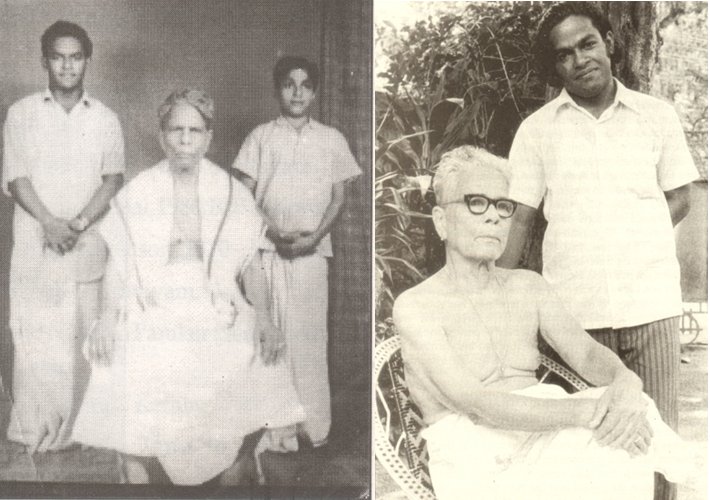 G. Venu (left) with Guru Chengannur Raman Pillai in 1967 and in 1976 During festival seasons Asan used to stay on a number of occasions in Guru Gopinath's younger brother Karunakaran Nair's house in Vattiyoorkavu. I used these occasions to clarify doubts regarding Kathakali mudras. All the rules and systems of traditional Kathakali were at Asan's fingertips. I had sometimes approached him with notes that pointed out the differences between Hastalakshanadipika and the way mudras are practiced. He used to empathetically say, "We were not taught by our Gurus based on the scriptural; this is how things were done for a long time." It was from those meetings I had with Asan that helped me confirm that importance should be given in my study of hand gestures to those concepts that had been nourished and sustained through practice that was largely oral. I had also utilized to the maximum, Asan's presence during the festival in Padmanabha Swamy temple. After recording about five hundred mudras I went to his house with the manuscript. When I entered his house in Chengannur, he received me in a very familiar way. Mankompu Sivasankara Pillai, one of his students and Kathakali artiste Nanu Aasan were with him. They were in the midst of writing a book about the southern style of Kathakali performance (Tekkan Chittayilulla Kathakali Attakramangal). I stayed in his house like a family member. On the third day of my arrival, Asan glanced through my manuscript and wanted me to demonstrate the mudras one by one. He commented on some of the mudras. Later, whenever I got time I used to go and sit beside him. While examining the mudras, he shared with me whatever knowledge he gained from his life-long experience in Kathakali. 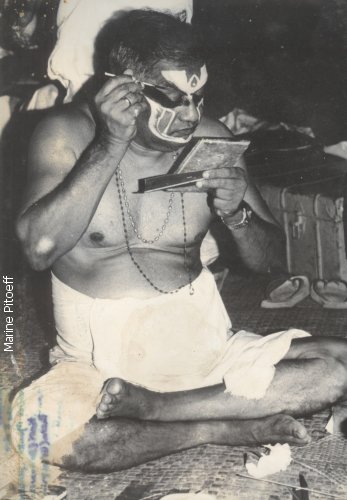 Guru Kalamandalam Krishnan Nair Guru Kalamandalam Krishnan Nair, the shining light and glory in Kathakali, was the chief guru at Vijnana Kaladevi in Chengannur for a few years. In the same period, I had worked there as a collaborator. The close friendship I had with Krishnan Nair Asan very often helped me to ask him about many mudras. Kalamandalam Krishnan Nair was the finest and most brilliant Kathakali performer ever produced by Kerala Kalamandalam from the time the institution started there till date. There is no doubt about it. Krishnan Nair, the ultimate Kathakali actor, was trained by Guru Kunju Kurup in the Southern style and learned other embellishments of Northern style from Guru Chandu Paniker, Kavalappara Narayanan Nair and Pattikkamthodi Ravunni Menon, adorn a unique place among the Kathakali artistes. He was a star performer from the very beginning itself. Slowly my collection of mudras grew in size. I met Sri. M.K.K Nair, all in all in Kathakali and Sri K.P.S. Menon, a great connoisseur and expert of the art of Kathakli. M.K.K. Nair was the chairman of Kerala Kalamandalam at that time. He was so impressed with my work, he took initiative and an article with pictures of my work was published as a cover story in the quarterly magazine of Kerala Kalamandalam. It was a great recognition for me. When all the gestures sketched in different notebooks were compiled into the big book, it became a huge collection of mudras. Though I had started this venture as a personal endeavour, it had soon become a curious piece of news in Kathakali circles. There were many who praised the effort and some questioned my qualifications to embark on such a great venture. For me, I was committed to it and so I thought I should get expert opinion on the graphic symbols I had evolved for the mudras. In those days, K.C.S. Paniker was considered the Dronacharya in the field of painting and sculpture in India. I went to Madras and met him. He was then busy with the construction of the artists' village 'Cholamandalam'. I was instructed to meet him at 7 in the morning in his studio in the College of Fine Arts. He was a renowned and great artist; I was only twenty two years old, and a Kathakali student. He welcomed me with great enthusiasm. He was happy that a Kathakali student had come to see him. I respectfully gave him my manuscript. With a lot of concentration and seriousness he went through the pages. He examined in great detail the system of graphic symbols provided for the basic mudras. He asked me to demonstrate some of the gestures. Then he said, "Look, these symbols have taken shape from your over-brimming desire. Therefore this work will certainly satisfy your needs." Then he explained in detail with examples, how Indian painting speaks very differently compared to realism. He explained, "It is possible to picturise as it is what we see with our eyes. But the Indian concept of art is to picturise what lies beyond what we see with our eyes". For me it was as if he had explained to me everything about that topic. A Guru is one who gives whatever knowledge in a given field to the new generation, and at the same time inspires them. The very presence of K.C.S Paniker was extremely inspiring for me. For proper guidelines for the arrangement and composition of a Kathakali mudra dictionary, I next approached N.V. Krishna Warrior, the renowned linguist, attakkatha writer, and above all an encyclopedic in himself. He was at that time the Director of the Language Institute. On the advice of N.V., in 1968 I published a brief pamphlet in English titled 'Alphabet of gestures in Kathakali' which introduced my system of notation and the important work on mudras under preparation. He wrote a scholarly and encouraging foreword to it. Three hundred copies were printed and sent to scholars in India and elsewhere. I continued my efforts to document the Kathakali mudras. To know and study the Kadathanadan style of hand gestures of North Kerala, I was in contact with the poet, attakatha writer and Kathakali exponent Kadathanattu K.Kunjunni Warrier and Kathakali Guru Kochu Govindan Asan. In my journey in search of Kathakali mudras, many eminent Kathakali performers like Guru Kizhpadam Kumaran Nair, the chief disciple of Pattikkamthodi Ravunni Menon, Chathunni Paniker, the last link of Kavungal Kalari, Pallippuram Gopalan Nair, Kaitakkatu Raman Pillai (disciple of Mathur Kunjupillai Paniker), Sadanam Krishnan Kutty, Nelliyode Vasudevan Namboodiri, Kalamandalm Rajan, Chandramana Govindan Nambutiri, V.P. Ramakrishnan Nair (disciple of Thekkinkattil Ramunni Nair) and Injakkattu Rama Chandran Pillai (disciple of Guru Mankulam Vishnu Namboothiri), Kathakali asans from all corners of Kerala and scholars have helped me in my study of these mudras. For fear that the list will be too long, I am not elaborating on them here. In 1977, the Kerala Sangeetha Nataka Akademi published 373 mudras from my collection as Kathakaliyile Kai Mudrakal (The Hand Gestures in Kathakali). Dr. Kapila Vatsyayan wrote the foreword for this book. After a few years, a second edition of the book was published by the Akademi. In 1984, the English translation of the book as Mudras in Kathakali was published by Natana Kairali. In 1994, the Department of Cultural Publications, Government of Kerala, published a collection of 587 mudras notated by me, entitled Kathakali Mudra Nighantu (Kathakali Mudra Dictionary). Again in the year 2000, Natana Kairali published another collection of 874 mudras named The Language of Kathakali. The Department of Cultural Publications, Government of Kerala, published this work in Malayalam with the title Kathakali Mudra Nighantu in the year 2005. I am extremely proud and feel gratified that I became the cause for the publication of Kathakali mudras in 6 editions. It would be fulfilling if my humble efforts to preserve this valuable treasure honed to perfection over the centuries is made possible through this work. While my study of Kathakali mudras progressed, I started to study the hand gestures of other art forms in Kerala. I next documented the gestures in Mohiniyattam, the lasya dance of Kerala. Inventing of a Notation System for Mudra: The language of Dance and Theatre in Kerala - Part 2 G. Venu is a performer, researcher and has invented a dance notation system for delineating mudra in dance and theatre in Kerala. He has also devised 'Navarasa sadhana' module as a transformative process for artistes seeking a deeper insight to the depths and diversity of human emotions. He is the Chairman, Natanakairali, Ammannur Chakyar Madhom, Irinjalakuda. Post your comments Pl provide your name and email id along with your comment. All appropriate comments posted with name and email id in the blog will also be featured in the site. |